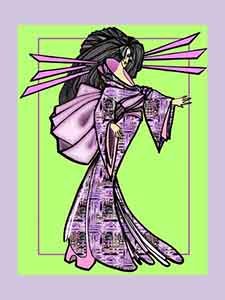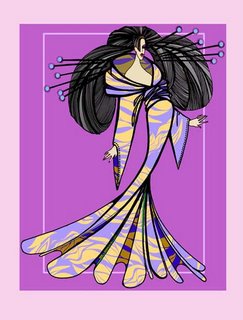Monday, December 18, 2006
Japan: Filling the God Vacuum
selected Resources about Kimono
Kimono:history and practice very informative site with topics included:Kimono,Kimono History, Japanese Clothing,Kimono Fabric, Kimono Pattern & How to Make a Kimono, Kimono Patterns & Kimono Styles, How to Wear a Kimono, Japanese Obi & How to Tie an Obi Sash, Japanese Yukata - The Summer Kimono,Kimono Robe & Japanese Robes, How to wear a Kimono Robe and Japanese Robes, Men's Kimono, Hakama Pants, Japanese Shoes & Japanese Sandal Types, Geta Sandals, Zori Sandals & Tatami Sandals, Tabi Socks, Children's Kimono, Wedding Kimono, Happi Coats & Japanese Festival Clothing Kimono site Traditional dress of China, Japan and Korea
KATEIGAHO japan arts and culture magazine, international edition
Japanese Family Crest site
Kimono for kids:Encyclopedia
Kimono Encyclopedia
Thursday, December 14, 2006
Friday, December 01, 2006
More on watercolor as a medium for art of kimono.

Sunday, November 26, 2006
"Japanese Tea Ceremony" and kimono
Acording to Takeya Yamasaki director of Cha-no-yu International.( The Japan Times Online)
"'Wearing the kimono teaches the value of tradition. Even modern young girls when they wear kimono begin to behave decorously. We have four principles of harmony, respect, purity and tranquillity. Since I have been practicing for years, even when I was furious at a negotiating table I could produce harmony. The tea ceremony teaches us in an innocent and compact way how to live our lives.'"
Monday, November 20, 2006
Kimono in watercolor medium
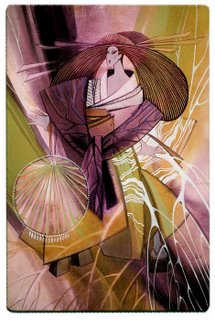
I feel that watercolor is the most natural medium for depicting of kimono. May be it is because of asymmetrical nature of kimono dressed body and because of visual fluidity of silhouette is better to in watercolor medium ? Watercolor allows you to not be exact . It allows you luxury of impreciseness. Image above created in watercolor media with some gouache editing.
Wednesday, November 15, 2006
certificate on how to wear a kimono??
Royal Gazette: "On the kimono, Ms Inoue said: “Today few women wear kimonos, except at a wedding or a funeral and not so many women know how now either. Hairdressers put kimonos on them, as in Japan have to have a certificate on how to wear a kimono.”"
Is it really ture ? Certificate on how to wear a kimono??
Thursday, November 09, 2006
Kimono design by Rachel Orren stylized by Nicole Arellano.
Tuesday, November 07, 2006
exports to Japan from China : Kimonos popularity is up?
"traditional suits of Kimono, its exports turnover touched $63 million, posted year–on–year rise of four percent. "
Year–on–year four percentrise ? Does it mean that Kimono's popularity is increasing in
Wednesday, November 01, 2006
Stylized kimono
In conclusion to "small face" reflections and asymmetry observations I would presume that the way to stylize image of Kimono is to emphasize asymmetry and exaggerate “small face” effect.
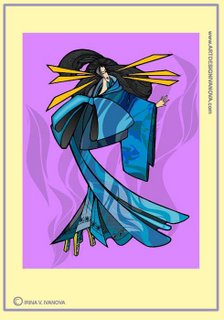
Tuesday, October 31, 2006
Kimono as asymmetry
In my view asymmetry is a foundation of beauty of kimono: It almost symmetrical in its pattern but ion the body it is always asymmetrical
if indeed : "The Japanese are masterful at asymmetry and kimono are superb examples. They are balanced but not perfectly symmetrical"According to Robyn Taylor Author form Australian artlink.com
as in ikebana which is acording to this text of von Marianne Sikora-Schoeck An Ikebana arrangement is always asymmetric. In ikebana "the chief characteristics-asymmetry" kimono is another dimention of this asymmetric concept . No image of kimono on the body is shows symmetry. Is it because as von Marianne Sikora-Schoeck wrote "the rules lead to asymmetry and imply it as a natural law. It is the premise for the never repeated variety of possibilities of arranging."?
Monday, October 30, 2006
Kagao "small face" digital art from my collection
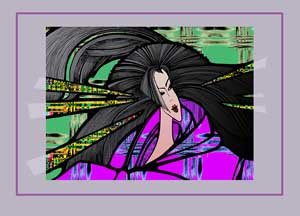
In continuation of "small face" topic I deiced to visualize my understanding of kagao. Of course it is eclectic and not authentic,. My goal was not a visual research but a metaphor. Initial title of this piece was “ Japanese visage “ but after kagao research ( which ids still going on ) I decided to re-name this piece . The new title is Kagao. This piece is digital print on canvas
20"x 30" from my art of kiomono collection.
Saturday, October 28, 2006
Art of Kimono is currently on the top in the Google blogsearch
Tuesday, October 17, 2006
Portraits of Beautiful Women
Japanese Ukiyo-e Printmakers Suzuki Harunobu (1724-70),( see his image to the right) Torii Kiyonaga (1752-1815) (see his artowrk to the left) did establish the system of beautiful proportions for women.
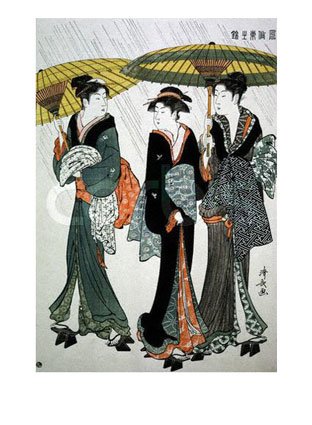
acording to this article form this site "Harunobu, ... depicted women as dolls in a world of fantasy. Kiyonaga's beauties were rendered with a special system of proportion known as hattoshin -- the subject's body being divided into eight parts. Kiyonaga was particularly regarded for the realism of his background scenes. Utamaro concentrated on half-length and bust portraits, and was noted for outlining the features of the face which, with decoratively designed hair and gorgeously lavish robes, created a sweeping composition, as well as for the emphasis he gave to facial expression, although casual"
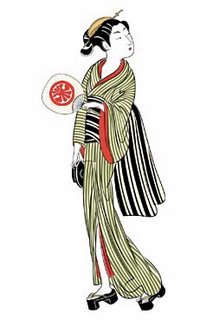
Acording to the autor of the article " western viewers may find it difficult at times to discern variation." However, approximately in the same time The British statesman and philosopher, Edmund Burke (1729–1797). wrote in his essay "On the Sublime and Beautiful"
Some hold it to be seven heads; some make it eight; whilst others extend it even to ten; a vast difference in such a small number of divisions! Others take other methods of estimating the proportions, and all with equal success. But are these proportions exactly the same in all handsome men? or are they at all the proportions found in beautiful women?
(read the full text )
May be Japanese and Western sense of human body proportions was identical in the same period of time?
KOGAO, or “little face”
Concept of KOGAO, or “little face” is absolutely mysterious to me. I bumped into this term when doing my research about proportions in Japanese ideal of women’s beauty. I see now that I scratched the surface of something very interesting. Below are some of my findings that I am going to think through step by step:
Small face as an ideal of beauty is correlated with concept of ideal proportions in Japanese tradition.
Acording to this source "while 'kogao' (small face) is a compliment, 'nekozura' is usually derogatory. "
Acording to The Japan Times Online "Height and build also enter into the small-face equation because any face will appear smaller when perched atop a long, leggy body. The ideal seems to be having a head that makes up one-eighth of your total height, expressed in Japanese as hattoshin (literally, eight-heads-body). This, my friend Yoshiko told me, is the head-body ratio most Westerners have, while Japanese noggins are more likely to be bigger in proportion to the body. That body type worked fine when Japanese wore kimono and big hair, she said, but makes it harder to look stylish in Western clothing."Acording to The sirens of Tokyo: "To obtain a kogao, or “little face,” there is an endless range of products, from sauna masks to creams. You cna see the image of the "stylish mask while taking a bath to achieve a cute small face (”kogao”).
There are special techniques and devises which can help to obtain “small face”
Saturday, October 14, 2006
kimono from Pointybunny's collection part 2
I am posting photos of Kimono’s detail and close up on kimono’s fabric from Pointybunny's collection. This is psting is follow up on my previous posting. Thank you, Pointybunny!
Wednesday, October 11, 2006
kimono from Pointybunny's collection
My fellow blogger Pointybunny was kind enough to photograph and send me images of kimonos form her collections . Beautiful kimonos!! Thank you ,Pointybunny!!! I am going to post some details and fabric’s images form Pointybunny’s collection shortly .Pointybunny publish fascinating blog Hello Gaijin! Adventures in
Monday, October 09, 2006
collage "Back View of Kimono" by Carrie Scott
The “Back View of Kimono” was inspired by the “Femmage” of Miriam Schapiro.
Schapiro celebrated the beauty in women’s use of material and technique to produce art that had been overlooked throughout history.
Also having a great interest in Eastern culture, I wanted to create something reminiscent of a kimono while still encompassing a bit of abstraction.
To support a more abstract feel, I created this by purely on my memory of the appearance of a kimono. I combined different patches of material resembling silk brocade in several layers and angles to complete “Back View of Kimono”.
Carrie Scott
Carrie is a graphic designer currently residing in
Tuesday, October 03, 2006
concept of kimono : at Mark K. Wheeler Gallery


Technically these pieces are digital rendering of original pencil drawings . The size of original prints is 30 inches x 40 inches ( approximately 75 cm x 100 cm)
Images presented on the show are 13” x 19” digital ink jet prints on paper . Title :
“concept of kimono “
Friday, September 29, 2006
art of kimono - A Xanga Blogring
I just created webring on
Xanga.com Let us see may be other interested in Kimono bloggers will share my search.Thursday, September 28, 2006
kimono fabric
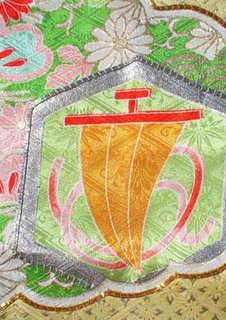
Beautiful kimono fabric from Japan courtesy of fellow blogger from Adventures in Tokyo blog . She promise to post more of Kimono related images from her collection. I am looking forward to that .
Wednesday, September 27, 2006
"Tuck a kimono blouse into a pencil skirt"- TURNING Japanese
 Acording to Lowell Sun Online - Fashion is turning Japanese:
Acording to Lowell Sun Online - Fashion is turning Japanese:Is it a new fashion trend ?

Slip into a flattering look that is making waves from Tokyo to Tyngsboro -- Kimono-inspired dresses and tops.
Kimono fashion?Why not? It is democratic:
it is not for size 2's only.
With flowing sleeves and fitted high-waists, most anyone call pull off this style.
Sunday, September 24, 2006
Friday, September 22, 2006
M. Kathleen Colussy presented: TraDigital
Author and designer M. Kathleen Colussy explore this direction making digital kimono demonstrating an excellent match of high tech printing technology and traditions of kimono.

Last year she presented digital Kimono on art show TraDigital at Mark K. Wheeler Gallery Fort Lauderdale
According to Kathleen Colussy: the works are comprised of several different mediums including painting, photography, and digital rendering. The pieces have all been digitally printed on substrates of natural and synthetic fibers.

According to Kathleen her hopes are that in her art one can see that she enjoys exploring the freedom of combining several mediums into art that embrace and celebrate life, cultural diversity, spirituality, faith and the art of story telling.
 For this reason she has referred to her art as Tra-digital, because her art reflects both the traditional and non-traditional means of expression
For this reason she has referred to her art as Tra-digital, because her art reflects both the traditional and non-traditional means of expressionKathleen is ever trying to combine high tech and high touch to express a message of choice and consequences.

In addition to the show, Kathleen will were signing her two newest books for Prentice Hall/Pearson Publishing Entitled:
Fashion Sleuth- How to Research and Resource the Internet
Rendering Fashion, Fabric and Prints with Adobe Illustrator
by: M. Kathleen Colussy and her co-author: Steve Greenberg

M. Kathleen Colussy
images are courtesy of M. Kathleen Colussy .
M. Kathleen Colussy teaches at Fashion Department of The Art Institute of Fort Lauderdale.
Tuesday, September 19, 2006
Sunday, September 17, 2006
Fabrics for Kimono:Chirimenis fabric of choice?
Chirimen is a type of Japanese silk crepe used for kimono.
According to Chirimen is wrinkled (crepe paper)Traditionally, women quilted leftover pieces of the fabric and made small ornaments that look like flowers, birds, animals, dolls and toys. The handiwork was handed down as a way to enhance one's needlework and artistic sense. At the class, one of the program members will teach how to make a silk camellia flower and other items.
For some reasons on according to this source
Yuzen paper, by Japanese handmade cotton texture paper. So,what is it, paper or fabric or both? We are trying to figure it out an we will post info on further research as far as we clarify that.
Any way, according to this commercial source "Chirimen silk. This is a kind of crepe silk.” And we will stick with this definition for the time being .
However on on the this Japanese fabric website Chirimen is not a silk, it is rayon and they use term "Hitokoshi" chirimen, which "has smaller surface wrinkles than other kinds of chirimen crepe."
Friday, September 15, 2006
international kimono?
By the beginning of the Showa period (1926–1989),men's clothing had become largely Western, and the business suit was standard apparel for company employees.This is apparently why men’s kimono in today’s Japan require additional efforts to stay afloat (see previous artofkimono posting ) knowing that “today, kimono have become much less common a sight in Japan.” . The question “What is the Future of Traditional Japanese Dress?” has no obvious answer for Japan. But international influence of kimono tradition is huge. I would say that kimono no longer belongs to Japan even though it originated in Japan the same way as tailored jacket no longer belongs to western Europe only.
In the same way as Harajuku fashion concept embraced western concept of fashion into Japanese cultural mode, western civilization absorbed idea of kimono.
Tuesday, September 12, 2006
must read:The Japanese Revolution in Paris Fashion
Monday, September 11, 2006
paper dolls kimono’s
According to this source
“Washi Ningyo (Japanese Paper Dolls) found its origin in a paper doll called "Anesama" Ningyo", which was favored by girls of all ages throughout Japan during the last 500 years.”
See examples of anesama and other Japanese paper craft on the page of National Clearinghouse for U.S.-Japan Studies of Indiana University
Interesting that there is special term for "elder sister doll" : which is “Anesama ningyoo” in Japanese. “There is a deep history to these paper dolls. In the Japanese feudal society, the common people were stuck within the social class in which they were born.”
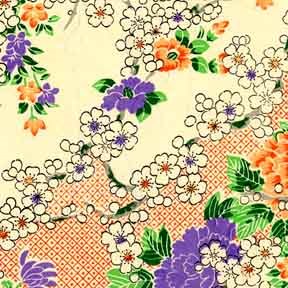
Kimono for paper dolls was created form CHIYOGAMI which is According to Kimberly Crane’s brief but very informative article at kimscrane.com a “type of Japanese paper decorated with brightly colored, woodblock-printed patterns.”
Some examples of CHIYOGAMI patterns Images are courtesy of choya.com
You can see as an illustrations for my brief research

You can some images of accessories form Chiyogami
Sadly enough wooden dolls and other Japanese craft
are out of the topic of kimono focused research , may be next time?
Wearing Propaganda: kimono as a political statement
Can kimono be a political statement? Sure it can take a look on Kimono’s of 1930’s and 1940’s and judge for yourself . Review form exhibition Wearing Propaganda: Textiles on the Home Front in
Sunday, September 10, 2006
kimono patterns
Art of Kimono, now in watercolor
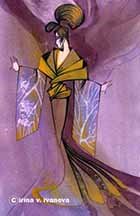
The medium is watercolor with light touch of gouache.
It is very special technique originally created by artist through years of practice and experimentation, by fusion of different traditions of watercolor painting into new innovative manner.
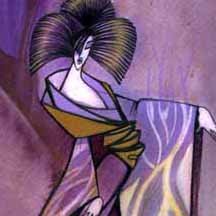
Excellent resource on Traditional dress of China, Japan and Korea
History and Concept of kimono as well as
Thursday, September 07, 2006
Kimono for Men: what makes the wearer iki ?
Saturday, August 26, 2006
Art of Kimono as a fine art
Art of Kimono is a set of small collections of artwork inspired by Japanese costume and art. Different collections are created in different medium in the range from digital applications to oil on canvas. The main idea is to explore same stylistic mode and same subject matter in variety of artistic media. You can see the collection on the web at www.artdesignivanova.com
